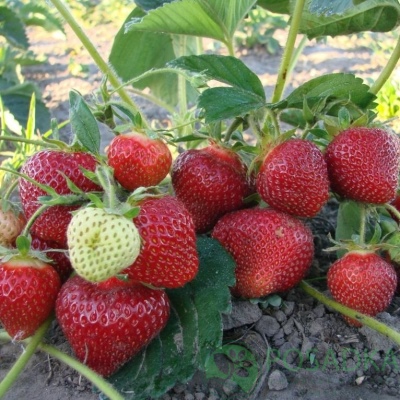
- Authors: Holland
- Taste: honey sweet
- The size: large
- Weight: 50-70 gr
- Yield rate: high
- Yield: up to 2 kg per bush
- Repairability: Yes
- disadvantages: low keeping quality
- Description of the bush: powerful
- Berry color: Dark red
The Miracle of the World strawberry variety was bred by breeders from Holland. It is currently very popular throughout Russia and Ukraine. Gardeners appreciate it for its large, tasty berries with a delicate aroma.
Description of the variety
The Miracle of the World strawberry belongs to the remontant varieties. It is characterized by powerful, medium-sized bushes 16-18 cm high with beautiful green leaves. White bisexual flowers are quite decorative. The plants of this variety have a well-developed root system. The Miracle of the World strawberry forms many mustaches, with which it is easy to propagate.
Ripening terms
As noted earlier, the Miracle of the World variety is characterized by remontant, that is, the genetic ability to bear fruit several times per season. Ripening of berries begins at the end of May and continues until frost. The duration of daylight hours does not significantly affect the formation of fruit buds.
Yield
Miracle of the World is a high-yielding strawberry variety. Up to 2 kg of berries can be harvested from one bush. Considering the presence of 3-5 harvest waves and the size of the berries, these are very good yield indicators.
Berries and their taste
The fruits of the variety are dark red in color, round-conical (at the beginning of the season) and elongated-conical (in autumn) in shape. The berries are large in size, the mass of one berry is 50-70 g. The fruit is juicy, but the pulp is not very dense, there are hollow areas. The taste of berries is honey-sweet, with a pronounced strawberry aroma. Strawberries of the Miracle of the World variety are characterized by low keeping quality, they do not tolerate long-term transportation.
Growing features
This variety does not require much maintenance and is suitable for beginner gardeners. Strawberries tolerate drought and lack of sun well, do not fade in the heat. You should cut off the mustache in time and do not forget about the spring feeding with nitrogen fertilizers. This is a hardy hybrid, but young plants need shelter for the winter with a layer of straw or other mulch. You should also know that the bushes of this variety are recommended to be grown in one place for 2-3 years, since the berries become very shallow over time.




Site selection and soil preparation
The Miracle of the World strawberries are planted in the spring after warming up the soil or in the fall about a month before the first frost. It thrives successfully even in lightly shaded areas. The planting soil should be composed of soil and manure (or compost). During planting, a distance of 40 cm between bushes and 50-60 cm between rows should be observed. Then it is imperative to water the planted plants well and mulch the soil around them.

Pollination
The Miracle of the World strawberry has bisexual flowers typical of all modern remontant varieties. This means that the plant pollinates itself. For further setting of berries, additional manual pollination is not required.

One of the important techniques in strawberry care is feeding. Regular fertilization guarantees a rich harvest. There are several different ways to feed strawberries, and each of them is designed for a specific period of plant development. During flowering, fruiting and after it, feeding should be different.

Diseases and pests
The Wonder of the World variety is characterized by high disease resistance, but can be affected by gray rot and strawberry mites.
Gray mold is a fungal disease that spreads rapidly throughout the plant. The leaves turn brown, and gray fluff appears on the berries. Infected bushes should be destroyed far from the site, treat the neighboring strawberries with "Switch". In order to prevent the disease, it is necessary to thin out fruit bushes, plant garlic or onions between the rows, process the planting with iodine solution (10 drops per bucket).
The strawberry mite feeds on strawberry juices. Its presence is indicated by twisted spotted leaves with tubercles (mite eggs), the bush stops growing, the berries dry out. For the destruction of these pests, insecticidal acaricidal agents are used, such as "Fufanon-Nova", "Neoron". But they cannot be used during the fruiting period due to toxicity. For prophylaxis, plants can be treated with onion husk tincture that is safe for berries (1 part of infused husk for 2 parts of water).

Strawberries are often subject to many dangerous diseases that can seriously undermine its condition. Among the most common are powdery mildew, gray mold, brown spot, anthracnose, and verticillosis. Before buying a variety, you need to inquire about its disease resistance.
Reproduction
The Wonder of the World variety can be propagated in different ways.
Seeds. In this case, the planting material is sown in February-March. Seeds are distributed without deepening over wet loose soil, sprinkling a little. Then the plantings are covered with foil and placed in a sunny place. When sprouts appear, the film must be removed.
Mustache.The most powerful mustache is selected on the plant, the rest are removed. When the roots are formed on the rosettes, the mustache is added dropwise, without cutting it off from the main bush. In August, the formed new bushes are cut off from the mother bush, and in the fall they are transplanted to a permanent place.
By dividing the bush. This is the easiest way to gently dig out a healthy 2-3 year old plant. With a sharp knife, disinfected in a solution of potassium permanganate, it is necessary to divide the bush into 3 parts so that each has a good root system. The resulting bushes can be immediately planted in the holes.



















































































